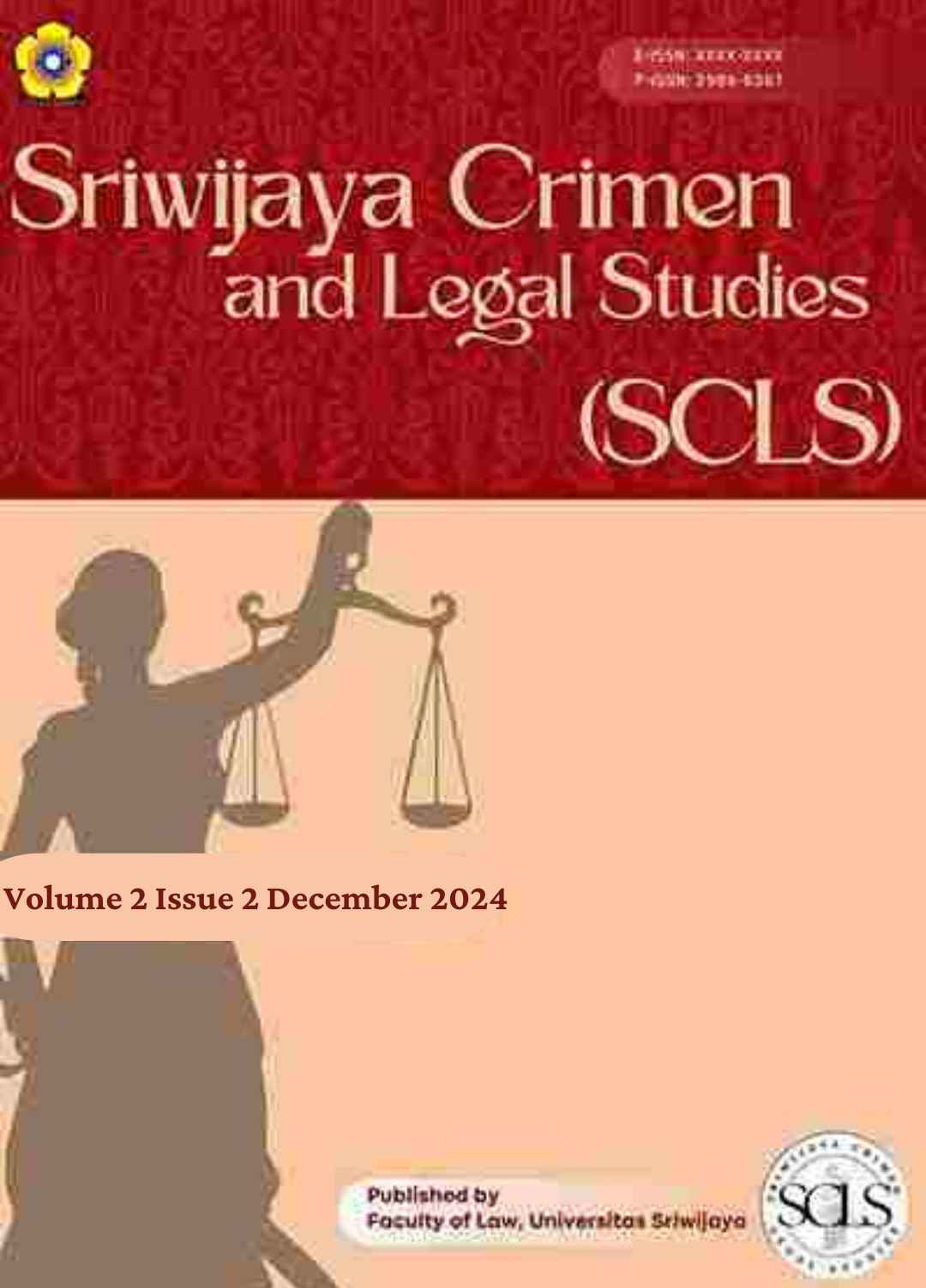NUCLEAR THREAT IN INDONESIA'S SOVEREIGN RIGHTS IMPACTED BY THE AUKUS AGREEMENT
DOI:
https://doi.org/10.28946/scls.v2i2.4045Abstract
The AUKUS agreement, a trilateral pact between Australia, the United Kingdom, and the United States, has increased tensions between Indonesia and Australia. The deal focuses on enhancing defense capabilities, particularly by developing nuclear-powered submarines. This has broader geopolitical implications for the Asia-Pacific region and affects bilateral relations between Indonesia and Australia. The two countries have historically shared strong economic ties and cooperation in various sectors but have also faced disagreements, particularly regarding issues like West Papua and regional security alignments. Indonesia views Australia's participation in AUKUS as potentially increasing foreign military presence in the region, raising concerns about sovereignty and maritime security. The focus on nuclear submarines also raises legal and environmental considerations under international maritime law, particularly concerning exclusive economic zones (EEZs) and resource sovereignty. With the world's largest maritime territory, Indonesia emphasizes adherence to UNCLOS and calls for dialogue to manage these tensions peacefully. Some perceive the AUKUS alliance as a response to balance China's growing power, but this polarizes regional perspectives, with Southeast Asian nations expressing mixed reactions ranging from support to apprehension. The alliance's implications extend beyond military capability enhancement to include technological cooperation and regional stability efforts. In conclusion, AUKUS aims to bolster security and technological advancement in the Indo-Pacific. Still, its implementation requires careful navigation of legal, environmental, and geopolitical complexities to mitigate potential regional tensions and uphold international norms.References
A, Budiawan Sidik. “Indonesia Dan ASEAN, Di Persimpangan Kekuatan AUKUS Dan China.†Kompas, 2023. https://www.kompas.id/baca/riset/2023/04/03/indonesia-dan-asean-di-persimpangan-kekuatan-aukus-dan-china.
BRIN. “Potensi Dan Tantangan Implementasi Belt and Road Initiative Bagi Ekonomi Indonesia,†2023. https://www.brin.go.id/news/116126/potensi-dan-tantangan-implementasi-belt-and-road-initiative-bagi-ekonomi-indonesia.
CNN INDONESIA. “Australia Klaim Pulau Pasir NTT, Masyarakat Ancam Gugat,†2022. https://www.cnnindonesia.com/internasional/20221024100544-106-864471/australia-klaim-pulau-pasir-ntt-masyarakat-ancam-gugat/2.
Fernandes, Inggrit, and M Rizqi Azmi. “Eksistensi Hak Berdaulat Dan Hak Yurisdiksi Indonesia Di Zona Ekonomi Eksklusif.†Jurnal Hukum Das Sollen 1, no. 4 (2018). https://doi.org/10.32520/das-sollen.v1i4.360.
Gao, Xiao, and Guy C. Charlton. “Australia and New Zealand in the West Papua Conflict.†THE DIPLOMAT, 2023. https://thediplomat.com/2023/04/australia-and-new-zealand-in-the-west-papua-conflict/.
GARIN, Artyom. “AUKUS AND THE SOUTH PACIFIC: FOREIGN POLICY AND SECURITY IMPLICATIONS FOR AUSTRALIA.†Southeast Asia: Actual Problems of Development, January 1, 2022, 223–33. https://doi.org/10.31696/2072-8271-2022-1-1-54-223-233.
Idris, Abdi Manab, Nugroho Adi Sasongko, and Yanif Dwi Kuntjoro. “AUKUS Cooperation in the Form of Australian Nuclear Submarine Technology for Stability in Indo Pacific Region.†International Journal of Research and Innovation in Social Science 06, no. 02 (2022): 745–50. https://doi.org/10.47772/ijriss.2022.6237.
Leonova. “The Impact of the Strategic Partnership AUKUS on the Geopolitical Situation in the Indo-Pacific Region9.†International Organisations Research Journal 17, no. 3 (2022): 144–56. https://doi.org/10.17323/1996-7845-2022-03-08.
McKenzie, Simon, and Eve Massingham. “AUKUS, the Regulation of the Ocean and the Legal Perils of Working Together,†2022, 1–26. https://doi.org/https://doi.org/10.31235/osf.io/rk963.
Mole, Denis. “Nuclear Submarines Could Lead to Nuclear Power for Australia.†THE STRATEGIST, 2021. https://www.aspistrategist.org.au/nuclear-submarines-could-lead-to-nuclear-power-for-australia/.
Redaksi. “Wajar, Indonesia Mewaspadai AUKUS.†Kompas, 2023. https://www.kompas.id/baca/opini/2023/03/16/wajar-indonesia-mewaspadai-aukus.
RI, Kemlu. “Statement on Australia’s Nuclear-Powered Submarines Program.†Australia, 2021. https://kemlu.go.id/portal/en/read/2937/siaran_pers/statement-on-australias-nuclear-powered-submarines-program.
Rothwell, Donald. “The Navigational Rights of AUKUS Submarines.†EASTASIAFORUM, 2023. https://eastasiaforum.org/2023/06/07/the-navigational-rights-of-aukus-submarines/.
Silalahi, Alma Evelinda, Rodon Pedrason, Rizerius Eko Hadisancoko, Surachman Surjaatmadja, Hikmat Zakky Almubaroq, and Agung Risdhianto. “Indonesia ’ S Perspective and Possible Strategies As the Chairmanship of Asean 2023 in Responding To the Emergence of Australia-Uk-Usa Defense Pact Perspektif Indonesia Dan Strategi Yang Mungkin Sebagai Ketua Asean 2023 Dalam Merespon Munculnya Pakta Pert.†Jurnal Pertahanan Dan Bela Negara 13, no. 2 (2023): 115–43. https://doi.org/https://doi.org/10.33172/jpbh.v13i2.13007.
Suhendang, Dadang. “Penegakan Hukum Hak Lintas Damai Bagi Kapal-Kapal Asing Di Perairan Indonesia.†Brawijaya Law Student Journal, 2015, 1–21. https://id.scribd.com/document/467582587/35668-ID-penegakan-hukum-hak-lintas-damai-bagi-kapal-kapal-asing-di-perairan-indonesia.
Tertrais, Bruno. “AUKUS and Its Implications for Asia, US-European Relations and Non-Proliferation.†Norwegian Institute of International Affairs., 2021.
Winarwati, Indien. “Penguatan Hak Berdaulat (Souvereign Right) Pada Zee Indonesia Dalam Rangka Perlindungan Sumber Daya Alam Laut.†Jurnal Ilmiah Hukum LEGALITY 24, no. 2 (2017): 172–80. https://doi.org/10.22219/jihl.v24i2.4268.
Downloads
Published
Issue
Section
License
Copyright (c) 2024 Sriwijaya Crimen and Legal Studies

This work is licensed under a Creative Commons Attribution-ShareAlike 4.0 International License.
As a journal author, you have rights for a large range of uses of your article, including use by your employing institute or company. These Author rights can be exercised without the need to obtain specific permission.
Authors publishing in SCLS journals have wide rights to use their works for teaching and scholarly purposes without needing to seek permission, including: use for classroom teaching by Author or Author's institution and presentation at a meeting or conference and distributing copies to attendees; use for internal training by author's company; distribution to colleagues for their research use; use in a subsequent compilation of the author's works; inclusion in a thesis or dissertation; reuse of portions or extracts from the article in other works (with full acknowledgement of final article); preparation of derivative works (other than commercial purposes) (with full acknowledgement of final article); voluntary posting on open web sites operated by author or author’s institution for scholarly purposes (follow CC by SA License).
Authors and readers can copy and redistribute the material in any medium or format, as well as remix, transform, and build upon the material for any purpose, even commercially, but they must give appropriate credit (cite to the article or content), provide a link to the license, and indicate if changes were made. If you remix, transform or build upon the material, you must distribute your contributions under the same license as the original.


